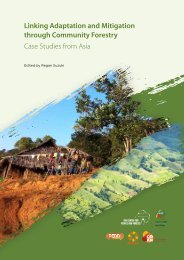Desktop Study on - Regional Climate Change Adaptation ...
Desktop Study on - Regional Climate Change Adaptation ...
Desktop Study on - Regional Climate Change Adaptation ...
Create successful ePaper yourself
Turn your PDF publications into a flip-book with our unique Google optimized e-Paper software.
Assessment of Capacity Gaps and Needs of South East Asia Countries<br />
in Addressing Impacts, Vulnerability and Adaptati<strong>on</strong> to <strong>Climate</strong> Variability and <strong>Climate</strong> <strong>Change</strong><br />
Gaps Identified in Programs and<br />
Studies<br />
Brahmi and Poumph<strong>on</strong>e (2002) c<strong>on</strong>cluded in their<br />
study that the media coverage as well as the relief<br />
funds and development assistances mainly focus<br />
<strong>on</strong> big disasters such as floods affecting densely<br />
populated . These regi<strong>on</strong>s are rice-producing areas<br />
of the country and relatively the `well off’ secti<strong>on</strong><br />
of the society, having access to fertile paddy land<br />
and infrastructure. The majority of the poorest<br />
communities and often ethnic minority groups are<br />
living in remote forests or mountainous regi<strong>on</strong>s and<br />
are not c<strong>on</strong>sidered under the financial ec<strong>on</strong>omic<br />
and technical support programs (Brahmi and<br />
Poumph<strong>on</strong>e, 2002).<br />
Although, the high importance of water for the<br />
socio-ec<strong>on</strong>omic development is recognized (ADB,<br />
2004; Lao PDR, 2009a), the NAPA observes that<br />
the instituti<strong>on</strong>al framework for the management of<br />
water resources is still c<strong>on</strong>sidered weak (Lao PDR,<br />
2009a). In order to cope with growing demands <strong>on</strong><br />
and limited supply of water resources – especially,<br />
in view of the need to adapt to climate change – a<br />
high priority project for strengthening instituti<strong>on</strong>al<br />
and human resource capacities in the water sector is<br />
proposed in the NAPA (Lao PDR, 2009a).<br />
Furthermore, farm level applicati<strong>on</strong>s in both<br />
water and food security sectors are necessary to<br />
understand the adaptive capacity of a household or<br />
farmers and to explain the socio-ec<strong>on</strong>omic status of<br />
communities in Lao PDR for appropriate measures.<br />
Recent Projects in the Socio-<br />
Ec<strong>on</strong>omic Sector<br />
A project titled, `<strong>Climate</strong> Impact and Adaptati<strong>on</strong><br />
Sectoral Strategy for Rural Infrastructure in Lao PDR´<br />
has been introduced by the ADB (ADB, 2009a). This is<br />
a nine m<strong>on</strong>ths pilot study under the ADB’s Small Grant<br />
Facility (SGF) and its <strong>Climate</strong> <strong>Change</strong> Adaptati<strong>on</strong> in<br />
Asia and the Pacific program. The project is being<br />
currently implemented by the c<strong>on</strong>sulting firm, RMSI<br />
and will investigate the impact of climate change<br />
<strong>on</strong> irrigati<strong>on</strong> infrastructure and other agricultural<br />
infrastructure, and ensuing policy implicati<strong>on</strong>s<br />
(flood risk assessment). The project is undertaken<br />
in the Southern provinces of Savannakhet, Saravane,<br />
Sek<strong>on</strong>g, Attapeu and Champassak. The resoluti<strong>on</strong><br />
of the risk assessment modelling will be at district<br />
and sub-basin levels. If successful, the project is seen<br />
as a precursor to a larger regi<strong>on</strong>al initiative. The<br />
main objective of this ADB SGF <str<strong>on</strong>g>Study</str<strong>on</strong>g> is to reduce<br />
climate change-induced flooding impacts <strong>on</strong> rural<br />
infrastructure and agriculture in Southern Lao PDR.<br />
Activities include the collecti<strong>on</strong> of data and the<br />
applicati<strong>on</strong> of a hydrological model, climate impact<br />
flood hazard-mapping for the Southern river basin,<br />
nati<strong>on</strong>al and provincial strategies workshops, and<br />
the disseminati<strong>on</strong> of Geographic Informati<strong>on</strong> System<br />
(GIS)-based flood risk maps (ADB, 2009a).<br />
In October 2009, a project <strong>on</strong> the northern rural<br />
structure development, funded by the ADB, was<br />
approved (ADB, 2009b). The project aims to<br />
enhance and diversify livelihood opportunities for<br />
rural communities in Northern Lao PDR through<br />
investment in rural,agricultural productivity and<br />
market access. With relevant to climate change<br />
adaptati<strong>on</strong>, the project provides the basis for<br />
mainstreaming climate change c<strong>on</strong>siderati<strong>on</strong>s into<br />
rural infrastructure investments and to implement<br />
cost-effective climate proofing measures in order<br />
to ensure the l<strong>on</strong>g-term protecti<strong>on</strong> of infrastructure<br />
(ADB, 2009b).<br />
CROSS-SECTORAL<br />
INSTITUTIONAL SETTINGS<br />
Two domains are identified as cross-sectoral<br />
instituti<strong>on</strong>al settings-climate change and disaster<br />
risk reducti<strong>on</strong>.<br />
<strong>Climate</strong> <strong>Change</strong><br />
<strong>Climate</strong> change has <strong>on</strong>ly in recent years become a<br />
high priority policy issue in Lao PDR (Roth, 2009). Lao<br />
PDR begun its climate change journey in 1995 with<br />
the ratificati<strong>on</strong> to the United Nati<strong>on</strong>s Framework<br />
C<strong>on</strong>venti<strong>on</strong> to <strong>Climate</strong> <strong>Change</strong> (UNFCCC) and by<br />
joining the Kyoto Protocol in 2003 (UNDP, 2009b).<br />
To deal with the increased challenges posed by<br />
climate change, the Department of Envir<strong>on</strong>ment<br />
(DoE), WREA, has been appointed as the UNFCCC<br />
nati<strong>on</strong>al focal point for the country’s climate change<br />
acti<strong>on</strong>s and initiatives (Roth, 2009). In 2008, the<br />
Prime Minister established the Nati<strong>on</strong>al Steering<br />
Committee <strong>on</strong> <strong>Climate</strong> <strong>Change</strong> (NSCCC) (Lao PDR,<br />
2009b). The NSCCC has drafted the Nati<strong>on</strong>al Strategy<br />
and its Acti<strong>on</strong> Plan <strong>on</strong> <strong>Climate</strong> <strong>Change</strong> (NSAPCC). In<br />
2009, the WREA published the Nati<strong>on</strong>al Adaptati<strong>on</strong><br />
Programme of Acti<strong>on</strong> to <strong>Climate</strong> <strong>Change</strong> (NAPA).<br />
Nati<strong>on</strong>al Steering Committee <strong>on</strong> <strong>Climate</strong> <strong>Change</strong><br />
(NSCCC).<br />
In 2008, the NSCCC and the <strong>Climate</strong> <strong>Change</strong> Office<br />
were established with the goal to coordinate the<br />
development of nati<strong>on</strong>al strategy to manage climate<br />
change and its impact, and to establish an acti<strong>on</strong><br />
25

















